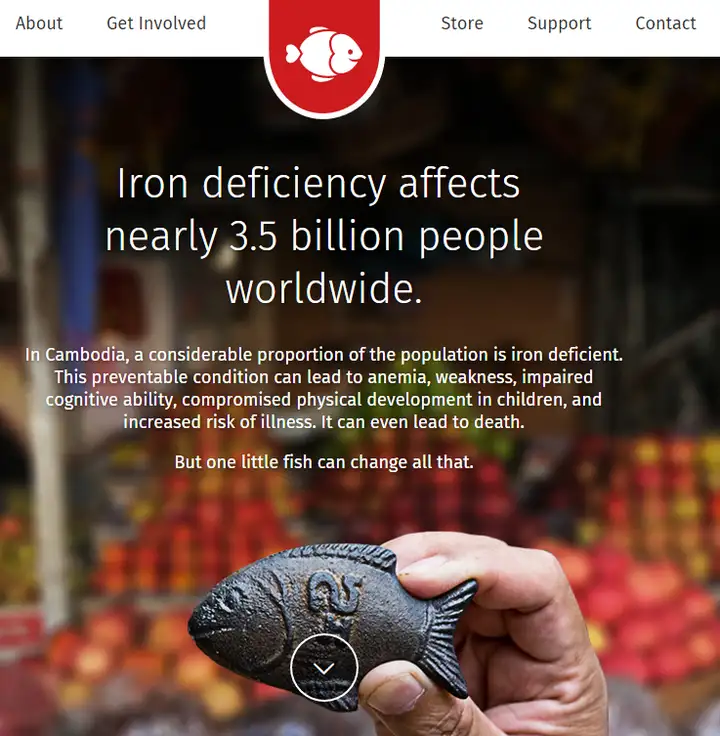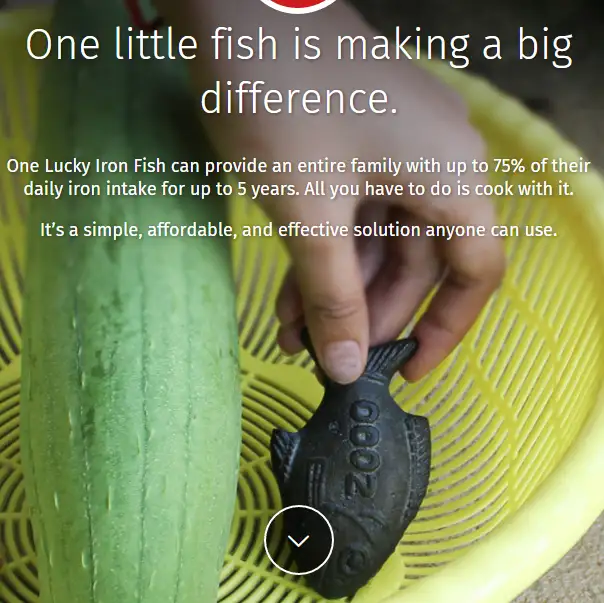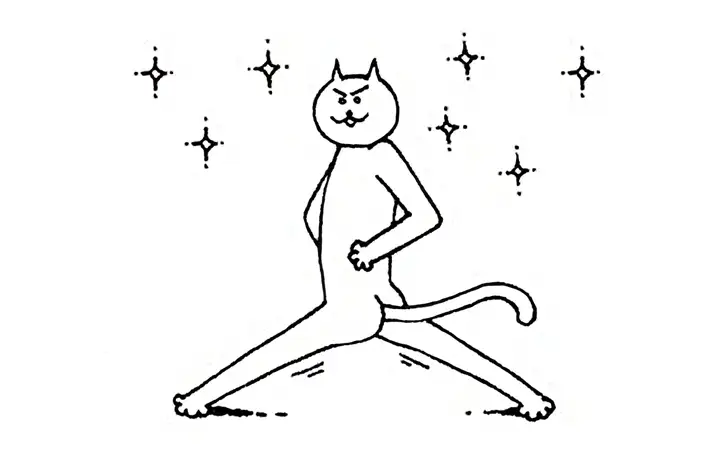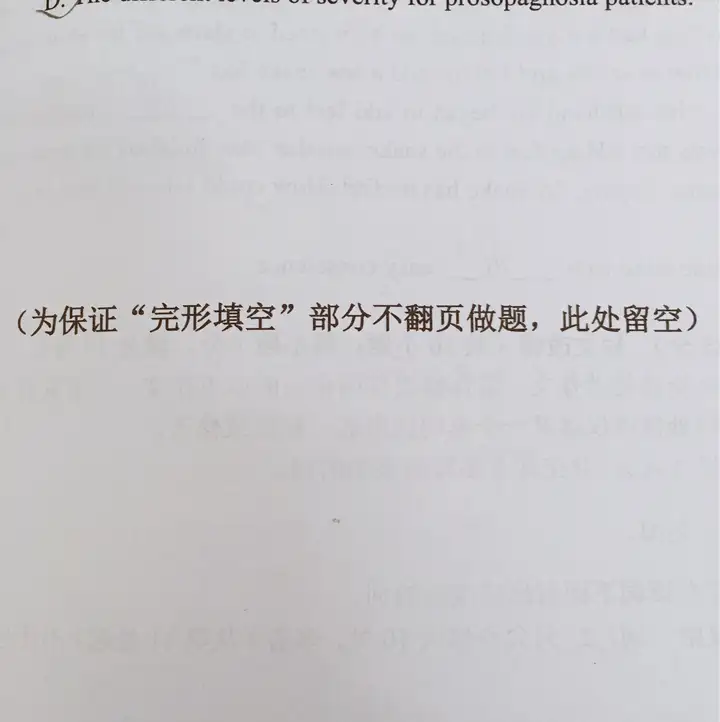
一条约掌心大小的小铁鱼,用来对抗柬埔寨地区严重的缺铁问题。
人体缺乏铁会引起多种疾病,如精神疲乏、缺铁性贫血、食欲不振、恶心呕吐、心脏功能异常等。铁的缺乏是一个全球性问题,在发展中国家尤为严重。通过食物补充铁,特别是在烹调过程中补充铁是一个非常简单而有效的补铁方式。一位名叫Chris Charles的博士生在旅行到柬埔寨的时候发现了当地严重的铁缺乏现象,决心在制作食物的过程引入含铁的物质来改善这种情况。他在当地发放小铁块,希望他们在洗菜做饭的过程中把小铁块扔到锅里来补充铁,可是当地人完全不买账。在和村落人交谈后他发现,鱼在当地象征着幸运、健康、快乐。Charles喜出望外,把小铁块铸成了小鱼的形状,重新推广,果不其然,终于赢得了积极的反馈。

每条小鱼仅仅7.6cm长,200克重,需花费5元加币,却能使用5年,每天为整个家庭提供推荐摄入铁量的75%,在9个月的时间里减少了当地50%的缺铁性症状。
将美好的愿景与贴心的考量相结合,就诞生了这个了不起的计划。附上官网链接:
和wikipedia:
————————⁽⁽ଘ( ˊᵕˋ )ଓ⁾⁾*我是一条非常想卖萌的分割线⁽⁽ଘ( ˊᵕˋ )ଓ⁾⁾*————————
10月18日更:
首先感谢大家的赞同,作为一个没见过什么世面的知乎小白,看到过百的赞真是感激涕零。很多朋友提出一个非常好的问题,在烹调中使用铁锅或者加入这种小铁块究竟能不能补铁。为了回答这个问题,我去特意查了点资料才回来

首先,铁锅能否补铁?
结论:流行病学实验发现了食用铁锅烹调的食物可以提高缺铁性贫血或铁缺乏人群血液中的血红蛋白含量。我们可以说铁锅是能补铁的。楼主时间有限,不能大范围认真检索了,而且好多paper都要钱啊,怨念脸……下面仅仅附上两篇paper和我非常走(ye)心(yu)的翻译:
1. Food prepared in iron cooking pots as an intervention for reducing iron deficiency anaemia in developing countries: a systematic review
P. D. Prinsen Geerligs, B. J. Brabin, A. A. A. Omari
Results Three trials were eligible for inclusion in the review. There is some evidence from these studies that eating food prepared in iron pots increases the haemoglobin concentration of anaemic/iron deficient individuals. This effect seems to be modified by compliance, users age, and the presence of malaria and hookworm. Compliance with pot use varies considerably between countries depending on several factors, including: size of the cooking pot, targeted user group, whether the pot is used as an extra or replacement pot, and familiarity with cast iron pots.
结果:三个实验符合本次综述的条件。这些研究提供了部分证据,表明食用铁锅烹调的食物可以增加缺铁性贫血/缺铁人群的血红蛋白浓度。这种效果会被研究对象服从性、年龄和是否有疟疾或十二指肠虫修饰。根据铁锅尺寸、目标人群、替代性使用铁锅或补充性使用铁锅和对铁制厨具的熟悉性的不同,实验服从性在不同国家中差异很大。
2. Effect of consumption of food cooked in iron pots on iron status and growth of young children: a randomised trial
SummaryBackground
In less-developed countries, novel strategies are needed to control iron-deficiency anaemia, the most common form of mainutrition.
Findings
407 children, one per household, entered the study. The change in haemoglobin concentration was greater in the iron-pot group than in the aluminium-pot group (mean change to 12 months 1·7 [SD 1·5] vs 0·4 [1·0] g/dL; mean difference between groups 1·3 g/dL [95% CI 1·1–1·6]). The mean differences between the groups in weight and length gain to 12 months (adjusted for baseline weight or length) were 0·6 cm (95% CI 0·1–1·0) and 0·1 kg (−0·1 to 0·3). The laboratory study showed that total and available iron was greatest in foods cooked in iron pots, except for available iron in legumes for which there was no difference between types of pot.
Interpretation
Ethiopian children fed food from iron pots had lower rates of anaemia and better growth than children whose food was cooked in aluminium pots. Provision of iron cooking pots for households in less-developed countries may be a useful method to prevent iron-deficiency anaemia.
这是一个在埃塞俄比亚儿童中做的RCT实验(randomized controlled trial, 是流行病学中烧钱、烧时间、烧研究员脑细胞的傲娇小公举,可以说是食物链顶端,做好了的RCT研究可参照性非常高)实验分为铁锅组和铝锅组,12个月后,铁锅组的儿童比铝锅组儿童血红蛋白浓度更高,患缺铁性贫血的比例更低。
文献点(tu)评(cao):
铁锅到底能不能补铁不能仅仅测试食物中的含铁量,因为食物中的铁不一定能被完全利用。而缺铁会导致血红蛋白含量偏低,是一个内在的指标,所以根据血红蛋白的含量来测试铁锅是否能补铁是比较科学的。这两篇都是流行病学研究,一个好的流行病学实验可以证实出正确的关联性,但不能论证背后的科学原理,就是说我们发现使用铁锅和血红蛋白含量升高同时出现了,但是为什么这样请不要问我。所以小伙伴们你们讲的什么游离态二价态什么的paper里是完全忽略掉的,鉴于我的化学知识差不多都还给老师了,我也不强答了,欢迎懂的朋友来补充~~~
有关于这个project的研究数据吗?
有的有的,请客官看这里:
http://cdn.intechopen.com/pdfs-wm/47492.pdf
The Lucky Iron Fish, an intervention based on the same principles of cooking with a cast ironpot, has shown in a randomized controlled trial to be effective in increasing hemoglobin184 by 11.6g/L, and reducing anemia by half in the study population, compared to the control group after 12 months [80]. This method involves boiling water or cooking soupwith the Lucky Iron Fish (an iron ingot shaped like a common Cambodian fish) for 10 minutesand adding some form of ascorbic acid (citrus juice, most commonly)
通过RCT我们发现,使用lucky iron fish十二个月后,平均提高实验组11.6g/L血红蛋白浓度,并减少了一半的缺铁性贫血患者。
这篇文章也提到了推广使用铁锅的一些问题:
The main limitations of using cast iron pots to improve iron status are that there was low
acceptability during randomized controlled trials [75-77]. Cast-iron pots were reported to be
heavy, rust easily, and required more attention for cooking due being prone to higher cooking
temperatures [75]. In one study it was found that participants were selling the cast iron pots
in the market in order to supplement low family incomes [78]. On the other hand, cast iron
pots required less wood for stoves since cooking times were faster, and the pots were consid‐
ered to be very durable [75].
实验组中对铁锅的接受度并不高,因为铁制品沉重、易生锈等特点,很多研究对象都不想使用铁锅。甚至还有参与者卖了分发的铁锅来补贴家用(传说中的砸锅卖铁嘛……),所以在很多地方推广得不好。
那么问题来了,这么好的东西在哪里可以买到呢?
简单的答案是,我也不知道!而且我觉得电脑前的你不需要买!以知乎人群来看,普通人(相对儿童、孕妇和有特殊疾病的人群来说)好好吃饭生活不乱来,一般不会怎么缺铁的。如果你缺铁了,可以适当进食红肉、动物肝脏、海产品和蔬菜来补充(当然严重的一定要去看医生!)比用萌萌的小鱼块还有效。但是在一个严重铁缺乏又极度贫困的地方,这种食补方法就好比“何不食肉糜?”
本人是公共卫生专业,这个project是讲global health时一个教授提到的。不能说它是一个多么成功多么震撼的案例,其背后的科学原理也没有得到完整的论述,但是在小范围内它确实解决了之前没有解决的问题。学习如何在适应当地经济、人文、政治的情况下解决公共卫生问题让人们都得到健康,是每个公卫人都在努力做的事。也希望科学能够不断发展,解答更多的问题,让我们能够透过现象看本质,推广更多好的project.
2016.02.20 更
再来啰嗦两句,这个项目与净水书很相似,有位知友在净水书那个问题下面也提到了这个项目。很多时候我们想改变的人们的意识和习惯,而不是单纯地给出一个solution,况且没有任何一个solution是万能的、普适的。它的价值更多地也超越本身物质的价格,因为项目背后还有很多工作在做。评论区就不一一回答了,谢谢你听我讲完这个故事~
更多回答
刚考完英语的,一定要回答一下
瞬间对老师有好感



